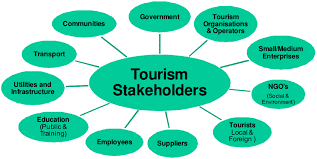- Introduction: MGBBT1TEN: Tourism Environment And Industry
- The emerging global trends in the travel and tourism industry in the 21st century
- Importance of Global Trends in Tourism Planning and Development
- The Benefits of these Global Trends to the Destination Country
- Tourism industry stakeholder can achieve their long-term sustainable goal
- Trends important for the decision-making of tourism development to meet objectives
- The changes in global trends affect the businesses in the tourism industry in terms of competitiveness globally
- The costs and benefits of these factors on the economy, society, and environment
Introduction: MGBBT1TEN: Tourism Environment And Industry
- The presentation states all the major trends but mainly focuses on sustainable tourism and niche tourism trends in the 21st century
- The report also includes the importance of a sustainable approach in the planning and expansion of tourism and tourism destinations. Here planning and development aim to discover and move forward to a theoretical and practical understanding of the intersection between tourism, planning, and development studies.
- The presentation also states the positive as well as the harmful collision of global trends on the economy, environment, and culture which are explained below.
- Culture: A population's communal ways of existence, along with its institutions, beliefs, and creative representations, are collectively referred to as its culture.
- Environment: The environment could be known as the impacts of all the alive and non-living things that have an impact on humans. Non-living or biologic components include water, soil, sunshine, rocks, and gas, while all live or biological fundamentals are creatures, plants, rainforests, fishermen, and seabirds.
- Economy: An ecosystem is a collection of interconnected consumption and production that determine how funds are allocated within a community.
Note: The presentation is based on global trends in the travel and tourism industry. All firms that primarily provide products or services that help businesses, satisfaction, or entertainment outside of the home surroundings cooperatively create up the tourism sector.
Struggling with tight deadlines? Discover Assignment Help Online to boost your grades with expert support. Our UK-based writers deliver custom, plagiarism-free work tailored to your university’s standards. Save time, reduce stress, and excel academically with affordable assistance. Click now for a free quote and take control of your assignments!
The emerging global trends in the travel and tourism industry in the 21st century
- The travel and tourism business includes many businesses such as transportation, hospitality, travel facilities, and entertainment.
- There are various new trends that are emerging in this industry such as personalized trips, the use of technology, leisure tourism, sustainable tourism, booking by mobile, wellness trips, experiential tourism, etc.
- Sustainable approach refers to determining a long-term strategy to maintain tourism with no harm to the ecological and monumental ecosystems (Carr al. 2017).
- Sustainable travel reduces the negative impacts of tourism and provides various advantages to travel destinations.
Note - Niche tourism is a particular kind of tourism that focuses on the needs of a specific target audience. Tourism destinations are positioned as niche travel products to attract and benefit a particular segment of the market (Carr et.al. 2017).
Examples of a sustainable approach
Bhutan
- Bhutan’s travel and tourism are controlled by the belief of “elevated value, short impact”.
- Bhutan used controlled tourism to accomplish this belief; it enforced rigid entry rules and tariffs on regular visitors.
- The tariff consists of essential expenses in a trip, like accommodation, a qualified tour guide, food, and climbing equipment.
- A big amount of the tariff is used for infrastructure development, providing free medical services and education.
Preservation of ‘volunteering’ in Belize
- UK tourism companies are focusing on Responsible Travel and responsible tourism. It promotes more accountable travel decisions through online content and organizing holiday packages that are ethical and sustainable.
- One holiday package presents tourists with the chance to volunteer at a conservation organization in Belize.
- Visitors are offered the chance to work five days per week in Belize's jungles as volunteers with a group of native environmentalists and specialists.
Fiji's solar-powered resort
- On the tropical Malolo Island, Six Senses Fiji is a resort with sustainable lavishness and civilizing sensitivity at its center.
- To reduce the practice of single-use plastic bottles, the resort runs completely on solar energy, on-site water cleaning system, and a rainwater collection system.
- Using a "worm-based septic system," recycling, composting, and a spotlight on cultivating as many of its herbs and vegetables as probable, the resort strive to be as waste-free as possible.
Note: Three examples of sustainable approaches are Controlled tourism in Bhutan, A solar power-driven resort in Fiji, and preservation ‘Volunteering’ in Belize.
Importance of Global Trends in Tourism Planning and Development
- Tourism planning includes making various strategies to develop travel and tourism in a particular destination country or place.
- The strategy to establish and maintain a viable tourism sector in a specific place while making sure the sector is highly sustainable and feasible is known as sustainable tourism planning and development (Torres-Delgado and Saarinen, 2017).
- One of the main objectives of tourism planning and improvement is reducing the negative impact on the environment and social factors. The sustainable approach of tourism focuses on the Protection of native animals, saving local culture, and helping out the local population efficiently and socially.
Note- Recognizing and evaluating the current global trends in the industry can help meet demand at a particular destination (Torres-Delgado and Saarinen, 2017). A sustainable approach to tourism is very important in tourism planning and improvement.
The Benefits of these Global Trends to the Destination Country
Sustainable tourism help in making effective tourism planning and development there are various important sustainable practices, and the top three are given below:
Sustainability Creates Added Value
- By accumulation value, sustainable tourism planning and improvement may also be beneficial to individuals working in the hospitality, hotel, and related industries (Kapera, 2018).
- An effective approach to think about this is that sustainability can act as a competitive differentiation when two tourism-related businesses are providing comparable possessions at comparable prices.
Create a Dialogue and Support the Local Community
- By creating dialogue, different tourism and travel companies can enhance the trust of the local community and make them feel that they are financing accountable businesses (Hall, 2019).
- When a travel company uses sustainable development, Staff feels more proud of their work, and the neighborhood can profit from the more jobs and money being invested in the regional industry.
Improve the Infrastructure of the Destination
- Sustainable tourism planning and development will invest in environment friendly infrastructure projects, which will improve the overall infrastructure of the area (Amir al. 2015).
- For instance, sustainable travel development will invest in trains which reduce overall emissions by transport.
- The travel companies provide various facilities including technology improvements, quicker net connections, superior roads and community transport, and the creation of fresh attractions to draw in tourists to the region.
Note- Firms that accept the issue and meet the growing demand for sustainable travel goods and services are likely to reap further rewards ( Kapera, 2018). For example, a company might be highlighted as a good example on websites, blogs, travel agencies, publications, and social media platform that center on sustainable travel. Since their objectives frequently depart, there can occasionally be resistance between the tourism sector and local communities (Hall, 2019). A more courteous and cohesive relationship between companies and the community can be achieved with the aid of the travel industry and tourism authorities who are working to launch sustainable tourism (Amir et.al. 2015).
Tourism industry stakeholder can achieve their long-term sustainable goal

Figure 1: tourism stakeholders
Government
- The government is an important stakeholder in the tourism industry, the government can achieve its sustainable goals by imposing various rules and standards for practices.
- The example rules visa policies to the protection of community infrastructure, a good number of tourism companies will function closely by way of Government.
Employees
- One of the main tourism stakeholders is the tourism employees’ .voyage, and the tourism industry provides employment directly or indirectly to a large number of people (Amerta, 2017).
- Employees can achieve their sustainable goals by receiving full employment and productive work in a decent workplace environment.
Note- Government and tourism employees are most important stakeholders of the tourism industry. They impact the tourism business more than any other factor. Employees in the travel and tourism industry are generally taking low-paid work in parts such as caterin,g hospitality and customer service (Amerta, 2017).
Suppliers
- The tourism industry depends on a broad range of suppliers. From industrial units producing bedclothes for hotel rooms, to farmers cultivating the fruits and vegetable supply in restaurants (Saito and Ruhanen, 2017).
- The supplier can achieve their sustainable goal by providing raw materials that are less or not at all harmful to the environment and society.
Tourism organizations and operators
- There are many tour companies and operators, such as travel agents, destination management organizations, airlines, travel bloggers, hotels, restaurants, etc.
- Tourism organization can achieve their sustainable goals by using environmental resources efficiently and effectively.
Note- Suppliers are the person which provides the necessary resources to carry out travel and tourism business. Tourism organizations are the main stakeholders and players in the industry. The organization has some sustainable objectives which can be achieved by maintaining necessary ecological processes and serving to preserve ordinary heritage and biodiversity (Saito and Ruhanen, 2017).
Trends important for the decision-making of tourism development to meet objectives
- Tourism development isthe method of founding and preserving a travel and tourism industry in a particular destination (Adu-Ampong, 2017).
- The sustainable tourism trend is very important in the rational and appropriate strategic decision in the tourism business. It helps in mitigating risk and uncertainty by grabbing opportunities.
- It helps in taking decisions by considering the environment, natural resources, and natural world.
These trends also help in achieving the following objective of tourism development (Var and Gunn, 2020):
- On condition that socio-economic settlement for the community who live in tourist destinations
- Conserve cultural heritage and create an authentic tourist experience
- bring tourists and local community together for a common benefit
- Create comprehensive and available tourist opportunities.
Note- At nearly all elementary levels, tourism expansion can be understood as the method of budding strategies and tactics to persuade tourism in a fastidious location (Adu-Ampong, 2017). The above stated objectives are most important objectives of tourism development and these are accomplished by sustainable approach (Var and Gunn, 2020).
The changes in global trends affect the businesses in the tourism industry in terms of competitiveness globally
- The concept of competition is present in today's business operations across all industry sectors, and many academics and professionals have focused their research and analysis on it because of the indirect impact it has on the income of company units.
- Tourism competitiveness depends on individual management, talent rivalry, image advertising, and management based on knowledge.
- A sustainable approach to niche marketing is increasing competition in a specific sector of the travel and tourism industry (Higgins-Desbiolles, 2018).
Note- Sustainable travel is a very important approach in the current market trend; Expedia group is a leading Travel Company with this approach in its operations (Higgins-Desbiolles, 2018).
The following graph represent the tourism sector global market size

Figure 2: The tourism sector global market size
The costs and benefits of these factors on the economy, society, and environment
Society
- Tourism's impact on society is generally not visible in short term and it is called the social-cultural impact of tourism on society (Amerta al. 2017). It slowly occurs over a period in both positive and negative ways.
- Tourism cost the indigenous identity and behavior of the destination country or place.
- It negatively impacts community structure, traditional lifestyle, collective relationships, etc.
- Sustainable tourism has many benefits for society as a whole. It creates employment opportunities, social development, etc.
Note- Society is impacted by tourism in both positive and negative ways, here; society means host communities (Amerta et.al. 2017). The new trend of sustainable development is bringing many socio-culture benefits to society.
Environment
- Sustainable development majorly focuses on the development of tourism while considering the protection and preservation of the environment (Negruşa al. 2015).
- Tourism development has many negative impacts on the environment such as a rise in pollution, discharge into the sea, loss of natural habitat, erosion of soil, etc.
- The benefits of sustainable tourism include the protection of the environment, wildlife, and natural resources.
Note- Sustainable development tries to reduce all the negative impacts of tourism by raising knowledge of environmental values (Negruşa et.al. 2015).
Economy
The following are positive and negative impacts of sustainable tourism on the destination country’s economy:
Benefits (Bramwell et.al. 2015)
- Provide employment
- Development of infrastructure
- More investment from foreign
- Helping local community
Costs (Unurlu, 2021)
- Opportunity costs
- Dependence on the travel and tourism sector makes the Host County's economy vulnerable
- Congestion
Note- Sustainable tourism gives more attention to environmental problems rather than economical problems (Bramwell et.al. 2015). There are various costs of tourism sector on destination country (Unurlu, 2021).
Conclusion
- The report concluded that sustainable tourism is the most emerging trend of the 21st The sustainable tourism sustainable approach refers to determining a long-term strategy to maintain tourism with no harm to the ecological and momentous ecosystems.
- Sustainable travel reduces the negative impacts of tourism; provides various advantages to travel destinations. This is very important for tourism development and destination development.
Note: The report also concluded that the sustainable approach reduces the negative impact of tourism and brings many benefits to the economy, society, and environment.
References
Adu-Ampong, E.A., 2017. Divided we stand: Institutional collaboration in tourism planning and development in the Central Region of Ghana.Current Issues in Tourism,20(3), pp.295-314.
Amerta, I.M.S., 2017. The role of tourism stakeholders at Jasri tourism village development, Karangasem regency.International Journal of Social Sciences and Humanities (IJSSH),1(2), pp.20-28.
Amerta, I.M.S., Sara, I.M. and Bagiada, K., 2018. Sustainable tourism development.International research journal of management, IT and social sciences,5(2), pp.248-254.
Amir, A.F., Abd Ghapar, A., Jamal, S.A. and Ahmad, K.N., 2015. Sustainable tourism development: A study on community resilience for rural tourism in Malaysia.Procedia-social and behavioral sciences,168, pp.116-122.
Bramwell, B., Higham, J., Lane, B. and Miller, G., 2017. Twenty-five years of sustainable tourism and the Journal of Sustainable Tourism: looking back and moving forward.Journal of Sustainable Tourism,25(1), pp.1-9.
Carr, A., Ruhanen, L. and Whitford, M., 2019. Indigenous peoples and tourism: the challenges and opportunities for sustainable tourism.Sustainable Tourism and Indigenous Peoples, pp.1-13.
Hall, C.M., 2019. Constructing sustainable tourism development: The 2030 agenda and the managerial ecology of sustainable tourism.Journal of Sustainable Tourism,27(7), pp.1044-1060.
Higgins-Desbiolles, F., 2018. Sustainable tourism: Sustaining tourism or something more?.Tourism management perspectives,25, pp.157-160.
Kapera, I., 2018. Sustainable tourism development efforts by local governments in Poland.Sustainable cities and society,40, pp.581-588.
Negruşa, A.L., Toader, V., Sofică, A., Tutunea, M.F. and Rus, R.V., 2015. Exploring gamification techniques and applications for sustainable tourism.Sustainability,7(8), pp.11160-11189.
Postma, A. and Schmuecker, D., 2017. Understanding and overcoming negative impacts of tourism in city destinations: conceptual model and strategic framework.Journal of Tourism Futures.
Saito, H. and Ruhanen, L., 2017. Power in tourism stakeholder collaborations: Power types and power holders.Journal of Hospitality and Tourism Management,31, pp.189-196.
Torres-Delgado, A. and Saarinen, J., 2017. Using indicators to assess sustainable tourism development: a review.New research paradigms in tourism geography, pp.31-47.
Unurlu, Ç., 2021. The effect of place personality on resident welcoming tourist through positive and negative impacts of tourism.International Journal of Tourism Research,23(4), pp.636-651.
Var, T. and Gunn, C., 2020.Tourism planning: Basics, concepts, cases. Routledge.



